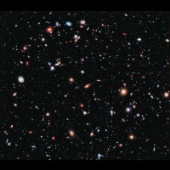ESA Science & Technology - News Archive
News archive
News archive
The European Space Agency (ESA) solicits through the present Announcement of Opportunity (AO) proposals for the provision of the Archive Access Co-Ordination Unit (CU9) in the Gaia Data Processing and Analysis Consortium (DPAC). The deadline for proposal submission is 10 January 2013.
Published: 19 November 2012
By combining the power of the NASA/ESA Hubble Space Telescope, NASA's Spitzer Space Telescope and one of nature's zoom lenses, astronomers have found what is probably the most distant galaxy yet seen in the Universe. The object offers a peek back into a time when the Universe was only 3 percent of its present age of 13.7 billion years.
Published: 15 November 2012
High above the main body of Mars' atmosphere is a region of weakly ionised gas, known as the ionosphere. New studies, based on observations from Mars Express, show that the dayside ionosphere is more variable and more complex than previously thought.
Published: 15 November 2012
Data from INTEGRAL and XMM-Newton have helped astronomers study how neutron stars accrete mass in highly obscured X-ray binaries. The results suggest a new method to estimate the mass of neutron stars.
Published: 9 November 2012
Data from INTEGRAL and XMM-Newton have helped astronomers study how neutron stars accrete mass in highly obscured X-ray binaries. The results suggest a new method to estimate the mass of neutron stars.
Published: 9 November 2012
A giant storm whirling on Saturn for the past two years has given planetary scientists new clues about the planet's atmosphere. The study is based on infrared observations from the Cassini orbiter and ground-based telescopes.
Published: 25 October 2012
Astronomers using the NASA/ESA Hubble Space Telescope have obtained a remarkable new view of a whopper of an elliptical galaxy, with a core bigger than any seen before. There are two intriguing explanations for the puffed up core, both related to the action of one or more black holes, and the researchers have not yet been able to determine which...
Published: 25 October 2012
A new study based on data from ESA's Cluster mission shows that it is easier for the solar wind to penetrate Earth's magnetosphere than had previously been thought.
Published: 24 October 2012
The winners of ESA's 'Explore the high-energy Universe' competition attended the INTEGRAL workshop in Paris last Wednesday, which marked the 10th anniversary of the launch of ESA's gamma-ray observatory, to present their winning entries to the science community.
Published: 22 October 2012
PR 35 2012 - Studying planets around other stars will be the focus of the new small Science Programme mission, Cheops, ESA announced today. Its launch is expected in 2017.
Published: 19 October 2012
ESA's INTEGRAL mission is celebrating the tenth anniversary of its launch and almost a decade of scanning the high-energy sky. The mission has shed new light on several classes of astronomical sources, galactic and extragalactic alike.
Published: 17 October 2012
Astronomers using INTEGRAL have detected the first direct signature of titanium-44 in supernova remnant 1987A. The discovery reveals large amounts of this isotope, demonstrating that its decay has been powering the source for the past 22 years.
Published: 17 October 2012
Astronomers using Hubble have studied a giant filament of dark matter in 3D for the first time. Extending 60 million light-years from one of the most massive galaxy clusters known, the filament is part of the cosmic web that constitutes the large-scale structure of the Universe.
Published: 16 October 2012
Ground- and space-based observations, including studies by ESA's XMM-Newton X-ray observatory, have provided unique insights into a star system dominated by two Galactic giants.
Published: 12 October 2012
ESA's Huygens probe bounced, slid and wobbled its way to rest in the 10 seconds after touching down on Saturn's moon, Titan, in January 2005, a new analysis reveals. The findings provide novel insight into the nature of the moon's surface.
Published: 11 October 2012
ESA's Herschel space observatory has discovered enough water vapour to fill Earth's oceans more than 2000 times over, in a gas and dust cloud that is on the verge of collapsing into a new Sun-like star.
Published: 9 October 2012
Pristine material that matches comets in our own Solar System have been found in a dust belt around the young star Beta Pictoris by ESA's Herschel space observatory.
Published: 3 October 2012
The Eight European Announcement of Opportunity for observations to be performed with Suzaku, starting in April 2013, is now open. Scientists belonging to institutions within ESA Member States are invited to respond. The deadline for receipt of proposals is 16 November 2012 at 16:00 CET.
Published: 3 October 2012
Venus Express has spied a surprisingly cold region high in the planet's atmosphere that may be frigid enough for carbon dioxide to freeze out as ice or snow.
Published: 1 October 2012
Astronomers have assembled a new, improved portrait of our deepest-ever view of the Universe. Called the eXtreme Deep Field, or XDF, the photo was assembled by combining ten years of Hubble Space Telescope observations taken of a patch of sky within the original Hubble Ultra Deep Field. The XDF is a small fraction of the angular diameter of the...
Published: 25 September 2012
—
20 Items per Page



















